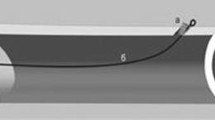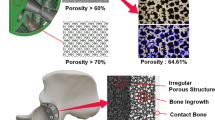Abstract
Background
Pegs made from cortical bone are used to fix osteochondral fractures and osteochondral dissecans. This technique has many advantages, but it requires long-term immobilization. This study examined the effect of surface roughness on fixation with bone and metal pegs.
Methods
Pegs with either rough or smooth surfaces were made of cortical bone from Japanese black cattle or from stainless steel (SUS316L). The mean roughness of the rough surface was 15.0 µm, whereas that of the smooth surface was less than 0.6 µm. Pegs were inserted into holes made in the distal femurs of 34 rabbits. At the time of surgery and 14 days later, mechanical tests and micro-computed tomography were performed.
Results
At the time of surgery, although the push-out forces were less than 0.3 N, the rough surface had a higher value than the smooth surface (P = 0.0002). No difference was observed according to the material (P = 0.54). Fourteen days after surgery, no significant difference was detected in the push-out forces between bone pegs with rough and smooth surfaces (489.0 ± 149.6 vs 478.3 ± 134.4 N (mean ± SD), respectively), but a marked difference was seen with the metal pegs (235.7 ± 115.7 vs 2.2 ± 1.6 N). The bone pegs with rough surfaces made contact with the recipient bone at the high points on the abraded surfaces. After the mechanical tests, the fusion was broken within the new bone for bone pegs with rough or smooth surfaces, but no breakage occurred at the junction of bone peg and new bone.
Conclusion
The surface roughness of bone pegs has little effect on bone-to-bone fusion 2 weeks postoperatively, unlike the effect with metal pegs.
Similar content being viewed by others
References
Lindholm S, Pylkkanen P. Internal fixation of the fragment of osteochondral dissecans in the knee by means of bone pins. Acta Chir Scand 1974;140:626–629.
Lindholm S, Pylkkanen P, Osterman K. Fixation of osteochondral fragments in the knee joint: a clinical survey. Clin Orthop 1977;126:256–260.
Slough JA, Noto AM, Schmidt TL. Tibial cortical bone peg fixation in osteochondritis dissecans of the knee. Clin Orthop 1991;267:122–127.
Oka Y, Ohta K, Fukuda H. Bone-peg grafting for osteochondritis dissecans of the elbow. Int Orthop 1999;23:53–57.
Kumai T, Takakura Y, Tanaka Y, Hayashi K. Fixation of osteochondral lesions of the talus using cortical bone pegs. J Bone Joint Surg Br 2002;84:369–374.
Flynn JM, Kocher MS, Ganley TJ. Osteochondritis dissecans of the knee. J Pediatr Orthop 2004;24:434–443.
Kocher MS, Tucker R, Ganley TJ, Flynn JM. Management of osteochondritis dissecans of the knee: current concept review. Am J Sports Med 2006;34:1181–1191.
Friederichs MG, Greis PE, Burks RT. Pitfalls associated with fixation of osteochondritis dissecans fragments using bioabsorbable screws. Arthroscopy 2001;17:542–545.
Scioscia TN, Giffin JR, Allen CR, Harner CD. Potential complication of bioabsorbable screw fixation for osteochondritis dissecans of the knee. Arthroscopy 2001;17:E7.
Buser D, Schenk RK, Steinemann S, Fiorellini JP, Fox CH, Stich H. Influence of surface characteristics on bone integration of titanium implants: a histomorphometric study in miniature pigs. J Biomed Mater Res 1991;25:889–902.
Zinger O, Anselme K, Denzer A, Habersetzer P, Wieland M, Jeanfils J, et al.Time-dependent morphology and adhesion of osteoblastic cells on titanium model surfaces featuring scale-resolved topography. Biomaterials 2004;25;2695–2711.
Wennerberg A, Albrektsson T. Suggested guidelines for the topographic evaluation of implant surfaces. Int Oral Maxillofac Implants 2000;15:331–344.
Shalabi MM, Gortemaker A, Van’t Hof MA, Jansen JA, Creugers NH. Implant surface roughness and bone healing: a systematic review. J Dent Res 2006;85:496–500.
Zweymüller KA, Lintner FK, Semlitsch MF. Biological fixation of a press-fit titanium hip joint endoprosthesis. Clin Orthop 1988;235:195–206.
Rubel IF, Seligson D, Lai JL, Voor MJ, Wang M. Pullout strengths of self-reinforced poly-L-lactide (SR-PLLA) rods versus Kirschner wires in bovine femur. J Orthop Trauma 2001;15:429–432.
Urist MR. Practical applications of basic research on bone graft physiology. AAOS Instructional Course Lectures, Vol 25. St Louis: Mosby; 1976. p. 1–26.
Urist MR, Mikulski A, Lietze A. Solubilized and insolubilized bone morphogenetic protein. Proc Natl Acad Sci U S A 1979;76:1828–1832.
Author information
Authors and Affiliations
About this article
Cite this article
Imade, S., Mori, R., Uchio, Y. et al. Effect of implant surface roughness on bone fixation: the differences between bone and metal pegs. J Orthop Sci 14, 652–657 (2009). https://doi.org/10.1007/s00776-009-1369-0
Received:
Accepted:
Published:
Issue Date:
DOI: https://doi.org/10.1007/s00776-009-1369-0




